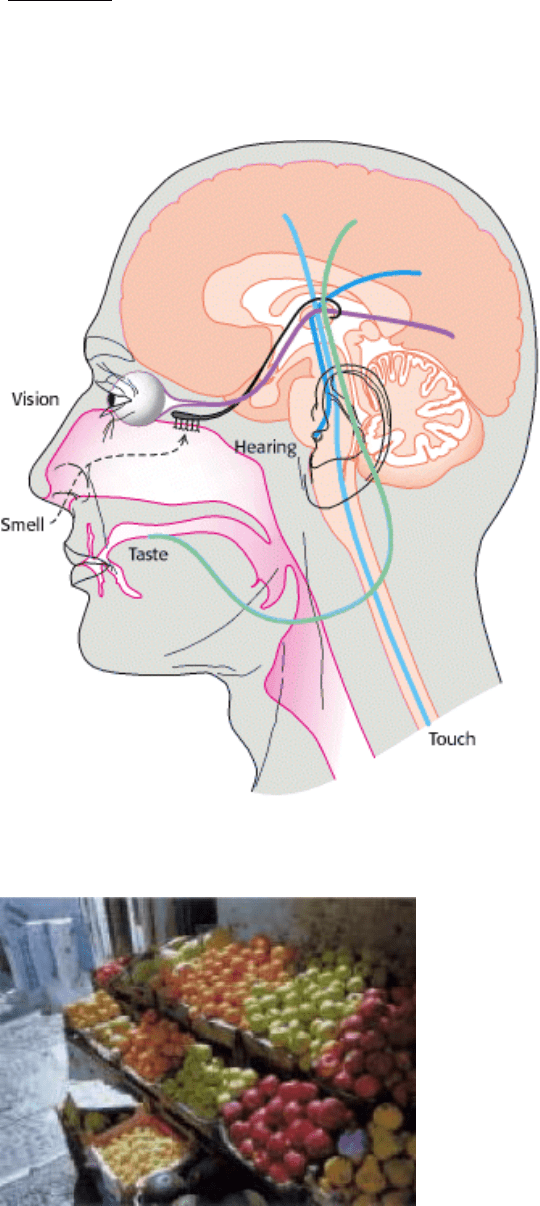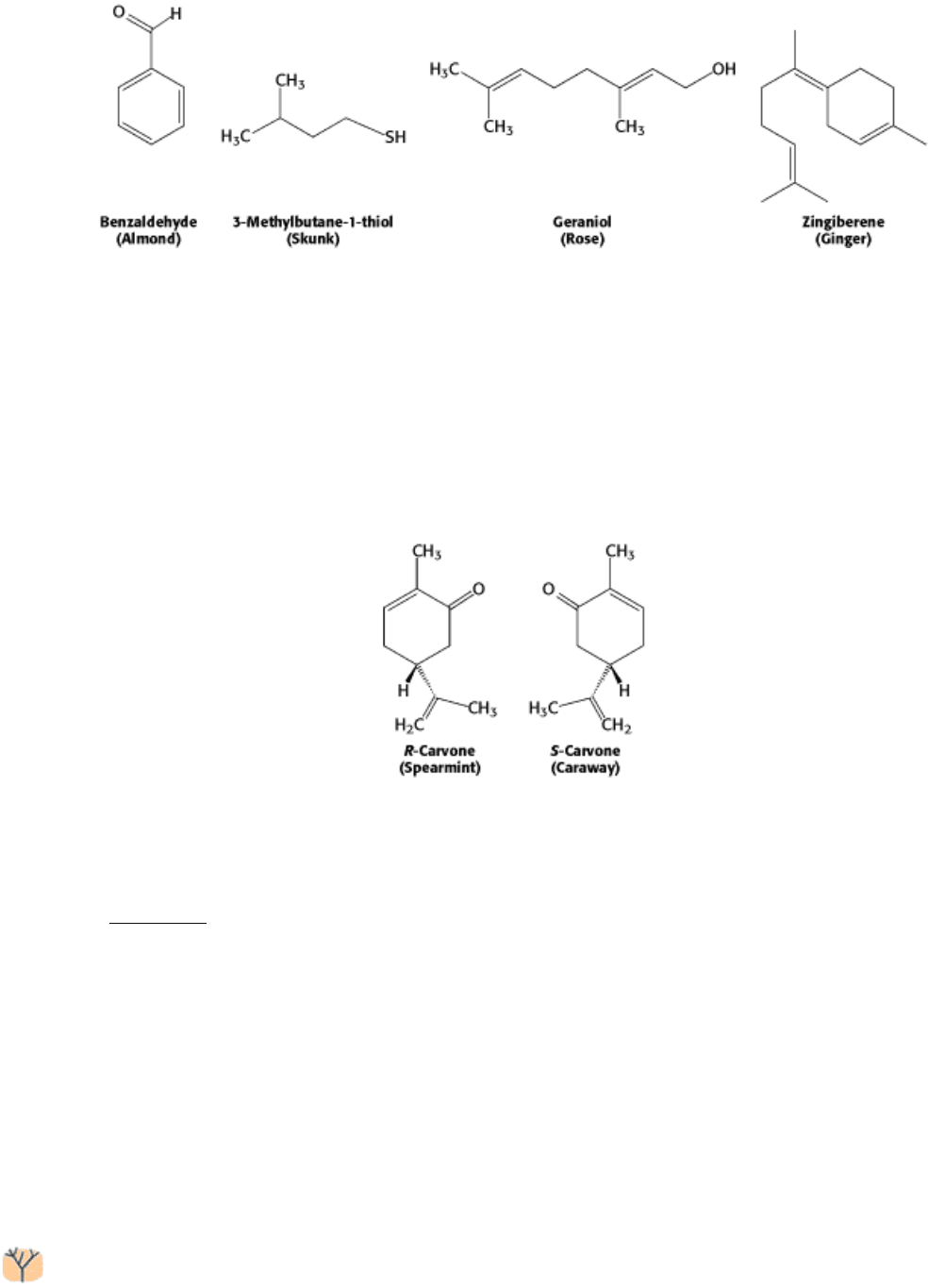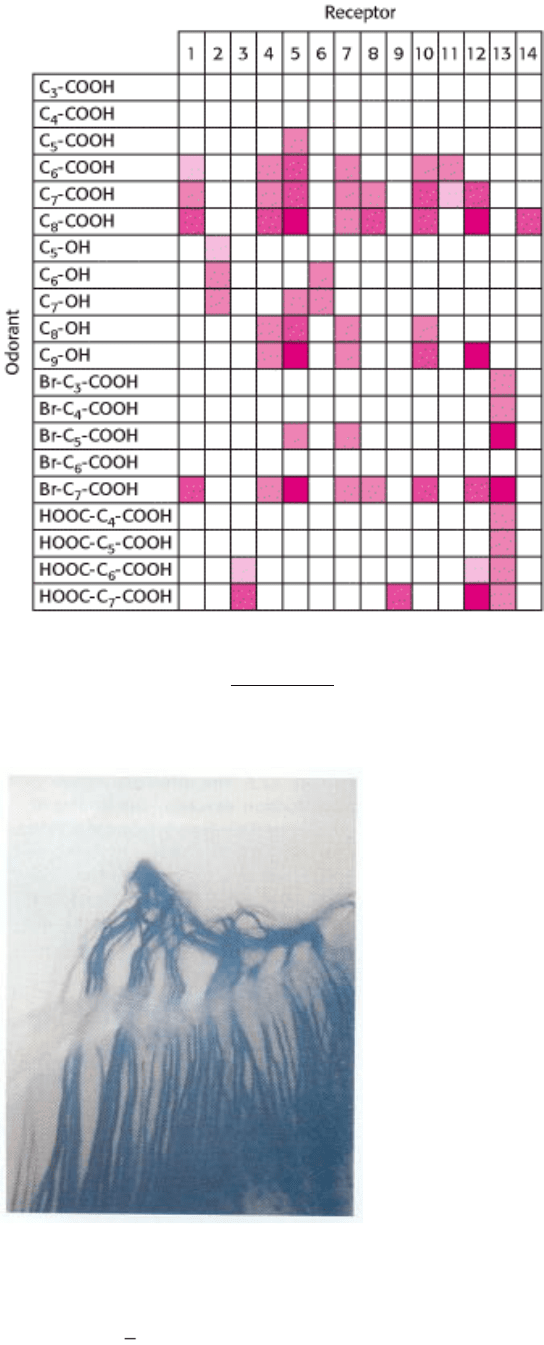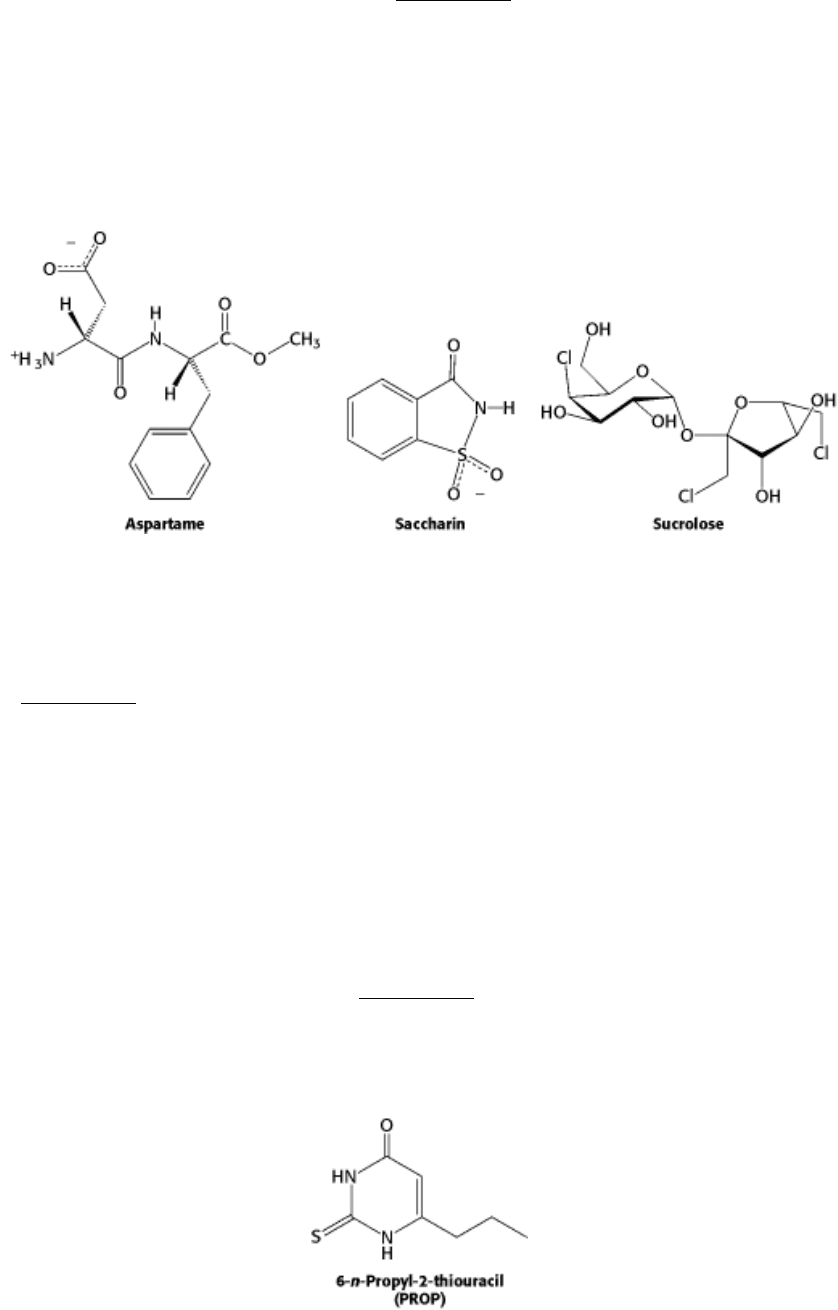Berg J.M., Tymoczko J.L., Stryer L. Biochemistry
Подождите немного. Документ загружается.


taste, and vision. Ion channels that are sensitive to mechanical stress are essential for hearing and touch.
In this chapter, we shall focus on the five major sensory systems found in human beings and other mammals: olfaction
(the sense of smell; i.e., the detection of small molecules in the air), taste or gustation (the detection of selected organic
compounds and ions by the tongue), vision (the detection of light), hearing (the detection of sound, or pressure waves in
the air), and touch (the detection of changes in pressure, temperature, and other factors by the skin). Each of these
primary sensory systems contains specialized sensory neurons that transmit nerve impulses to the central nervous system
(Figure 32.1). In the central nervous system, these signals are processed and combined with other information to yield a
perception that may trigger a change in behavior. By these means, our senses allow us to detect changes in our
environments and to adjust our behavior appropriately.
IV. Responding to Environmental Changes 32. Sensory Systems
Figure 32.1. Sensory Connections to the Brain. Sensory nerves connect sensory organs to the brain and spinal cord.
IV. Responding to Environmental Changes 32. Sensory Systems

Color Perception. The photoreceptor rhodopsin (bottom), which absorbs light in the process of vision, consists of the
protein opsin and a bound vitamin A derivative, retinal. The amino acids (shown in red) that surround the retinal
determine the color of light that is most efficiently absorbed. Individuals lacking a light-absorbing photoreceptor for the
color green will see a colorful fruit stand (top) as mostly yellows (middle). (Top, middle) from L. T. Sharpe, A.
Stockman, H. Jagle, and J. Nathans. (1999) -Opsin genes, cone photopigments, color vision, and color blindness, in
Color Vision: from Genes to Perception, pp. 3
51. K. Gegenfurtner, L. T. Sharpe, eds. Cambridge University Press.]
IV. Responding to Environmental Changes 32. Sensory Systems
32.1. A Wide Variety of Organic Compounds Are Detected by Olfaction
Human beings can detect and distinguish thousands of different compounds by smell, often with considerable sensitivity
and specificity. Most odorants are relatively small organic compounds with sufficient volatility that they can be carried
as vapors into the nose. For example, a major component responsible for the smell of almonds is the simple aromatic
compound benzaldehyde, whereas the sulfhydryl compound 3-methylbutane-1-thiol is a major component of the smell of
skunks.

What properties of these molecules are responsible for their smells? First, the shape of the molecule rather than its other
physical properties is crucial. We can most clearly see the importance of shape by comparing molecules such as those
responsible for the smells of spearmint and caraway. These compounds are identical in essentially all physical properties
such as hydrophobicity because they are exact mirror images of one another. Thus, the smell produced by an odorant
depends not on a physical property but on the compound's interaction with a specific binding surface, most likely a
protein receptor. Second, some human beings (and other animals) suffer from specific anosmias; that is, they are
incapable of smelling specific compounds even though their olfactory systems are otherwise normal. Such anosmias are
often inherited. These observations suggest that mutations in individual receptor genes lead to the loss of the ability to
detect a small subset of compounds.
32.1.1. Olfaction Is Mediated by an Enormous Family of Seven-Transmembrane-Helix
Receptors
Odorants are detected in a specific region of the nose, called the main olfactory epithelium, that lies at the top of the
nasal cavity (Figure 32.2). Approximately 1 million sensory neurons line the surface of this region. Cilia containing the
odorant-binding protein receptors project from these neurons into the mucous lining of the nasal cavity.
Biochemical studies in the late 1980s examined isolated cilia from rat olfactory epithelium that had been treated with
odorants. Exposure to the odorants increased the cellular level of cAMP, and this increase was observed only in the
presence of GTP. On the basis of what was known about signal-transduction systems, the participation of cAMP and
GTP strongly suggested the involvement of a G protein and, hence, 7TM receptors. Indeed, Randall Reed purified and
cloned a G protein α subunit, termed G
(olf)
, which is uniquely expressed in olfactory cilia. The involvement of 7TM
receptors suggested a strategy for identifying the olfactory receptors themselves. cDNAs were sought that (1) were
expressed primarily in the sensory neurons lining the nasal epithelium, (2) encoded members of the 7TM receptor
family, and (3) were present as a large and diverse family to account for the range of odorants. Through the use of these
criteria, cDNAs for odorant receptors from rats were identified in 1991 by Richard Axel and Linda Buck.
The odorant receptor (hereafter, OR) family is even larger than expected: more than 1000 OR genes are present in
the mouse and the rat, whereas the human genome encodes between an estimated 500 and 750 ORs. The OR
family is thus one of the largest gene families in human beings. However, more than half the human odorant receptor
genes appear to be pseudogenes that is, they contain mutations that prevent the generation of a full-length, proper
odorant receptor. In contrast, essentially all rodent OR genes are fully functional. Further analysis of primate OR genes

reveals that the fraction of pseudogenes is greater in species more closely related to human beings (Figure 32.3). Thus,
we may have a glimpse at the evolutionary loss of acuity in the sense of smell as higher mammals presumably became
less dependent on this sense for survival.
The OR proteins are typically 20% identical in sequence to the β-adrenergic receptor (Section 15.1) and from 30 to 60%
identical with each other. Several specific sequence features are present in most or all OR family members (Figure 32.4).
The central region, particularly transmembrane helices 4 and 5, is highly variable, suggesting that this region is the site
of odorant binding. That site must be different in odorant receptors that bind distinct odorant molecules.
What is the relation between OR gene expression and the individual neuron? Interestingly, each olfactory neuron
expresses only a single OR gene, among hundreds available. Apparently, the precise OR gene expressed is determined
largely at random. The mechanism by which all other OR genes are excluded from expression remains to be elucidated.
The binding of an odorant to an OR on the neuronal surface initiates a signal-transduction cascade that results in an
action potential (Figure 32.5). The ligand-bound OR activates G
(olf)
, the specific G protein mentioned earlier. G
(olf)
is
initially in its GDP-bound form. When activated, it releases GDP, binds GTP, and releases its associated β γ subunits.
The α subunit then activates a specific adenylate cyclase, increasing the intracellular concentration of cAMP. The rise in
the intracellular concentration of cAMP activates a nonspecific cation channel that allows calcium and other cations into
the cell. The flow of cations through the channel depolarizes the neuronal membrane and initiates an action potential.
This action potential, combined with those from other olfactory neurons, leads to the perception of a specific odor.
Conceptual Insights, Signaling Pathways: Response and Recovery presents
an animated version of Figure 32.5 and a comparison to visual signal
transduction (Figure 32.5).
32.1.2. Odorants Are Decoded by a Combinatorial Mechanism
An obvious challenge presented to the investigator by the large size of the OR family is to match up each OR with the
one or more odorant molecules to which it binds. Exciting progress has been made in this regard. Initially, an OR was
matched with odorants by overexpressing a single, specific OR gene in rats. This OR responded to straight-chain
aldehydes, most favorably to n-octanal and less strongly to n-heptanal and n-hexanal. More dramatic progress was made
by taking advantage of our knowledge of the OR signal-transduction pathway and the power of PCR (Section 6.1.5). A
section of nasal epithelium from a mouse was loaded with the calcium- sensitive dye Fura-2 (Section 15.3.1). The tissue
was then treated with different odorants, one at a time, at a specific concentration. If the odorant bound to and activated
an OR, that neuron could be detected under a microscope by the change in fluorescence caused by the influx of calcium
that occurs as part of the signal-transduction process. To determine which OR was responsible for the response, cDNA
was generated from mRNA that had been isolated from single identified neurons. The cDNA was then subjected to PCR
with the use of primers that are effective in amplifying most or all OR genes. The sequence of the PCR product from
each neuron was then determined and analyzed.
Using this approach, investigators analyzed the responses of neurons to a series of compounds having varying chain
lengths and terminal functional groups (Figure 32.6). The results of these experiments appear surprising at first glance
(Figure 32.7). Importantly, there is not a simple 1:1 correspondence between odorants and receptors. Almost every
odorant activates a number of receptors (usually to different extents) and almost every receptor is activated by more
than one odorant. Note, however, that each odorant activates a unique combination of receptors. In principle, this
combinatorial mechanism allows even a relatively small array of receptors to distinguish a vast number of odorants.
How is the information about which receptors have been activated transmitted to the brain? Recall that each neuron
expresses only one OR and that the pattern of expression appears to be largely random. A substantial clue to the
connections between receptors and the brain has been provided by the creation of mice that express a gene for an easily
detectable colored marker in conjunction with a specific OR gene. Olfactory neurons that express the OR-marker protein
combination were traced to their destination in the brain, a structure called the olfactory bulb (Figure 32.8). The
processes from neurons that express the same OR gene were found to connect to the same location in the olfactory bulb.

Moreover, this pattern of neuronal connection was found to be identical in all mice examined. Thus, neurons that express
specific ORs are linked with specific sites in the brain. This property creates a spatial map of odorant-responsive
neuronal activity within the olfactory bulb.
Can such a combinatorial mechanism truly distinguish many different odorants? An "electronic nose" that functions by
the same principles provides compelling evidence that it can (Figure 32.9). The receptors for the electronic nose are
polymers that bind a range of small molecules. Each polymer binds every odorant, but to varying degrees. Importantly,
the electrical properties of these polymers change on odorant binding. A set of 32 of these polymer sensors, wired
together so that the pattern of responses can be evaluated, is capable of distinguishing individual compounds such as n-
pentane and n-hexane as well as complex mixtures such as the odors of fresh and spoiled fruit.
32.1.3. Functional Magnetic Resonance Imaging Reveals Regions of the Brain
Processing Sensory Information
Can we extend our understanding of how odorants are perceived to events in the brain? Biochemistry has provided the
basis for powerful methods for examining responses within the brain. One method, called functional magnetic resonance
imaging (fMRI), takes advantage of two key observations. The first is that, when a specific part of the brain is active,
blood vessels relax to allow more blood flow to the active region. Thus, a more active region of the brain will be richer
in oxyhemoglobin. The second observation is that the iron center in hemoglobin undergoes substantial structural changes
on binding oxygen (Section 10.4.1). These changes are associated with a rearrangement of electrons such that the iron in
deoxyhemoglobin acts as a strong magnet, whereas the iron in oxyhemoglobin does not. The difference between the
magnetic properties of these two forms of hemoglobin can be used to image brain activity.
Nuclear magnetic resonance techniques (Section 4.5.1) detect signals that originate primarily from the protons in water
molecules but are altered by the magnetic properties of hemoglobin. With the use of appropriate techniques, images can
be generated that reveal differences in the relative amounts of deoxy- and oxyhemoglobin and thus the relative activity
of various parts of the brain.
These noninvasive methods reveal areas of the brain that process sensory information. For example, subjects have been
imaged while breathing air that either does or does not contain odorants. When odorants are present, the fMRI technique
detects an increase in the level of hemoglobin oxygenation (and, hence, brain activity) in several regions of the brain
(Figure 32.10). Such regions include those in the primary olfactory cortex as well as other regions in which secondary
processing of olfactory signals presumably takes place. Further analysis reveals the time course of activation of
particular regions and other features. Functional MRI shows tremendous potential for mapping regions and pathways
engaged in processing sensory information obtained from all the senses. Thus, a seemingly incidental aspect of the
biochemistry of hemoglobin has yielded the basis for observing the brain in action.
IV. Responding to Environmental Changes 32. Sensory Systems 32.1. A Wide Variety of Organic Compounds Are Detected by Olfaction

Figure 32.2. The Main Nasal Epithelium. This region of the nose, which lies at the top of the nasal cavity, contains
approximately 1 million sensory neurons. Nerve impulses generated by odorant molecules binding to receptors on the
cilia travel from the sensory neurons to the olfactory bulb.
IV. Responding to Environmental Changes 32. Sensory Systems 32.1. A Wide Variety of Organic Compounds Are Detected by Olfaction
Figure 32.3. Evolution of Odorant Receptors. Odorant receptors appear to have lost function through conversion into
pseudogenes in the course of primate evolution. The percentage of OR genes that appear to be functional for each
species is shown in parentheses.

IV. Responding to Environmental Changes 32. Sensory Systems 32.1. A Wide Variety of Organic Compounds Are Detected by Olfaction
Figure 32.4. Conserved and Variant Regions in Odorant Receptors. Odorant receptors are members of the 7TM
receptor family. The green cylinders represent the seven presumed transmembrane helices. Strongly conserved residues
characteristic of this protein family are shown in blue, whereas highly variable residues are shown in red.
IV. Responding to Environmental Changes 32. Sensory Systems 32.1. A Wide Variety of Organic Compounds Are Detected by Olfaction
Figure 32.5. The Olfactory Signal-Transduction Cascade. The binding of odorant to the olfactory receptor activates a
signaling pathway similar to those initiated in response to the binding of some hormones to their receptors (see Section
15.1). The final result is the opening of cAMP-gated ion channels and the initiation of an action potential.
IV. Responding to Environmental Changes 32. Sensory Systems 32.1. A Wide Variety of Organic Compounds Are Detected by Olfaction
Figure 32.6. Four Series of Odorants Tested for Olfactory Receptor Activation.

IV. Responding to Environmental Changes 32. Sensory Systems 32.1. A Wide Variety of Organic Compounds Are Detected by Olfaction
Figure 32.7. Patterns of Olfactory Receptor Activation. Fourteen different receptors were tested for responsiveness to
the compounds shown in Figure 32.6. A colored box indicates that the receptor at the top responded to the compound at
the left. Darker colors indicate that the receptor was activated at a lower concentration of odorant.
IV. Responding to Environmental Changes 32. Sensory Systems 32.1. A Wide Variety of Organic Compounds Are Detected by Olfaction
Figure 32.8. Converging Olfactory Neurons. This section of the nasal cavity is stained to reveal processes from
sensory neurons expressing the same olfactory receptor. The processes converge to a single location in the olfactory
bulb. [From P. Mombaerts, F. Wang, C. Dulac, S. K. Chao, A. Nemes, M. Mendelsohn, J. Edmondson, and R. Axel. Cell
87(1996):675
689.]

IV. Responding to Environmental Changes 32. Sensory Systems 32.1. A Wide Variety of Organic Compounds Are Detected by Olfaction
Figure 32.9. The Cyranose 320. The electronic nose may find uses in the food industry, animal husbandry, law
enforcement, and medicine. [Courtesy of Cyrano Sciences.]
IV. Responding to Environmental Changes 32. Sensory Systems 32.1. A Wide Variety of Organic Compounds Are Detected by Olfaction
Figure 32.10. Brain Response to Odorants. A functional magnetic resonance image reveals brain response to odorants.
The light spots indicate regions of the brain activated by odorants. [N. Sobel et al., J. Neurophysiol. 83:537
551 2000
537; courtesy of Nathan Sobel.]
IV. Responding to Environmental Changes 32. Sensory Systems
32.2. Taste Is a Combination of Senses that Function by Different Mechanisms
The inability to taste food is a common complaint when nasal congestion reduces the sense of smell. Thus, smell greatly
augments our sense of taste (also known as gustation), and taste is, in many ways, the sister sense to olfaction.
Nevertheless, the two senses differ from each other in several important ways. First, we are able to sense several classes
of compounds by taste that we are unable to detect by smell; salt and sugar have very little odor, yet they are primary
stimuli of the gustatory system. Second, whereas we are able to discriminate thousands of odorants, discrimination by
taste is much more modest. Five primary tastes are perceived: bitter, sweet, sour, salty, and umami (the taste of
glutamate from the Japanese word for "deliciousness"). These five tastes serve to classify compounds into potentially

nutritive and beneficial (sweet, salty, umami) or potentially harmful or toxic (bitter, sour). Tastants (the molecules
sensed by taste) are quite distinct for the different groups (Figure 32.11).
The simplest tastant, the hydrogen ion, is perceived as sour. Other simple ions, particularly sodium ion, are perceived as
salty. The taste called umami is evoked by the amino acid glutamate, often encountered as the flavor enhancer
monosodium glutamate (MSG). In contrast, tastants perceived as bitter or sweet are extremely diverse. Many bitter
compounds are alkaloids or other plant products of which many are toxic. However, they do not have any common
structural elements or other common properties. Carbohydrates such as glucose and sucrose are perceived as sweet, as
are other compounds including some simple peptide derivatives, such as aspartame, and even some proteins.
These differences in specificity among the five tastes are due to differences in their underlying biochemical mechanisms.
The sense of taste is, in fact, a number of independent senses all utilizing the same organ, the tongue, for their expression.
Tastants are detected by specialized structures called taste buds, which contain approximately 150 cells, including
sensory neurons Figure 32.12). Fingerlike projections called microvilli, which are rich in taste receptors, project from
one end of each sensory neuron to the surface of the tongue. Nerve fibers at the opposite end of each neuron carry
electrical impulses to the brain in response to stimultation by tastants. Structures called taste papillae contain numerous
taste buds.
32.2.1. Sequencing the Human Genome Led to the Discovery of a Large Family of 7TM
Bitter Receptors
Just as in olfaction, a number of clues pointed to the involvement of G proteins and, hence, 7TM receptors in the
detection of bitter and sweet tastes. The evidence included the isolation of a specific G protein α subunit termed
gustducin, which is expressed primarily in taste buds (Figure 32.13). How could the 7TM receptors be identified? The
ability to detect some compounds depends on specific genetic loci in both human beings and mice. For instance, the
ability to taste the bitter compound 6-n-propyl-2-thiouracil (PROP) was mapped to a region on human chromosome 5 by
comparing DNA markers of persons who vary in sensitivity to this compound.
This observation suggested that this region might encode a 7TM receptor that responded to PROP. Approximately 450
kilobases in this region had been sequenced early in the human genome project. This sequence was searched by
